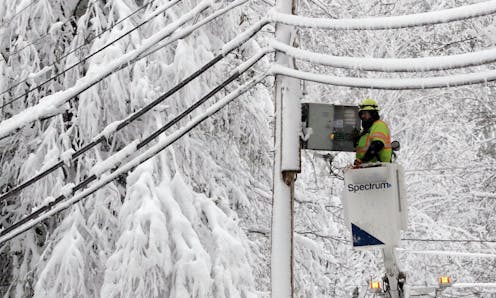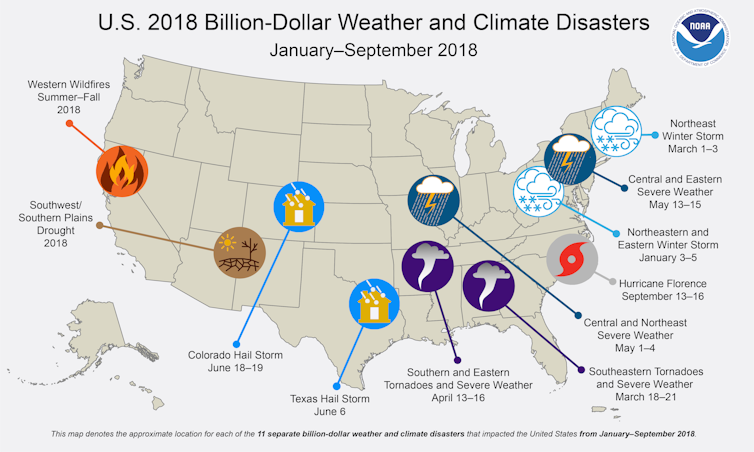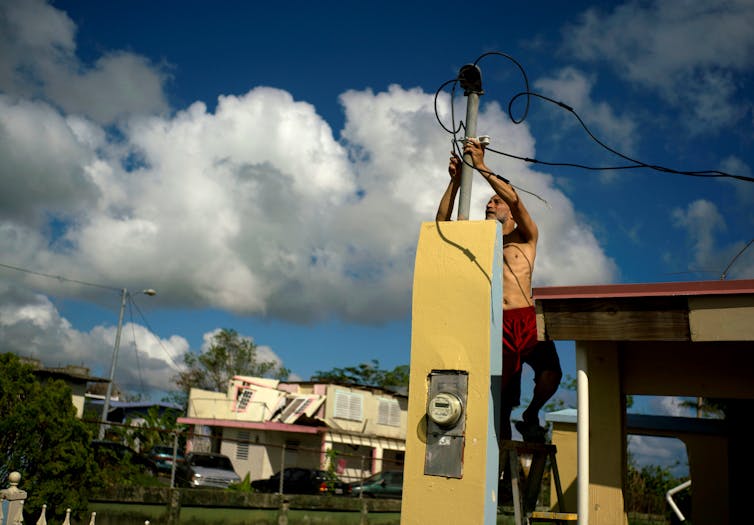Keeping the lights on during extreme cold snaps takes investments and upgrades
Making electric grids better able to withstand extreme weather events will require teamwork from engineers, researchers and the government.

Polar vortexes. Hurricanes. Wildfires.
With climate change making extreme weather events more frequent and intense, it is getting harder to keep the lights on and HVAC systems running.
As a power system researcher, I believe utilities need to get better at withstanding disasters and the disruption they cause. Investing more heavily is key, especially in infrastructure upgrades, renewable energy and microgrids – small and self-sufficient sources of power that help consumers either stay off the grid by choice or simply stay connected during outages.
Many kinds of damage
Different kinds of weather can obstruct access to electricity.
In extreme cold snaps, like the one that froze a large swathe of the U.S. in early 2019, crucial equipment like circuit breakers, switches, grid sensors and other electromechanical support equipment can operate slower or faster than normal, sometimes leading to plants shutting themselves down – potentially causing power outages.
Around 300,000 customers lost power in Michigan and New Jersey due to winter storms in 2018.
In 2019, 1,500 customers temporarily lost power when power lines snapped in Kenosha County, Wisconsin, and thousands more had to shiver through the coldest night in decades in Minnesota’s Twin Cities region and parts of Illinois.
During hurricanes, high-speed winds can knock down transmission and overhead distribution power lines, as happened in 2018 with Hurricane Michael in Florida and Hurricane Maria in Puerto Rico in 2017.
Unfortunately, there are no easy fixes.
While burying power lines underground protects them from gusts, it then makes them vulnerable to floods and earthquakes. In areas that regularly experience high temperatures, electricity use can spike due to heavy demand for air conditioning during heat waves. And when demand exceeds supply, it can cause outages.
Within the first nine months of 2018, 11 disastrous weather events hit the U.S. caused more than US$1 billion in damages. The overall cost from a total of 238 U.S. weather and climate disasters since 1980 that exceeded $1 billion in inflation-adjusted dollars amounts to $1.5 trillion.

Gaining resilience
For power companies, reliability is about keeping the lights on and providing power in a consistent manner to support day-to-day life. Power companies, government agencies and researchers also must shore up resilience by preparing for, absorbing, adapting to and rapidly recovering from extreme weather and other emergencies.
To this end, the Energy Department is spending up to $50 million over three years to support grid modernization and resilience. This includes developing and enhancing microgrids with high penetration of clean distributed energy resources and emerging grid technologies. Examples include smart meters that can transmit real-time outage alerts and smart switches, devices which can detect problems in the grid and restore power automatically.
Utilities now can predict outages and their impacts on electric grids before a storm even strikes. They can use artificial intelligence technologies, weather forecasts and historical damage data to estimate the size and location of possible outages.
This helps utilities allocate repair crews and equipment during emergencies. It also helps utilities pre-position generators where they are most likely to be needed.
Responding better
After hurricanes and other extreme weather bouts are over, crews are dispatched to repair damage and restore power as fast as possible. Most utilities still rely on operators’ experience in scheduling crew works. But some now use advanced outage management systems to automate and expedite this process.
Utilities have historically relied on customers contacting them to report damage and outages. Without modern technology, there can be lags before a power company discovers problems it must fix when no one complains – as is inevitable during evacuations.
The proliferation of digital smart meters – electrical devices that record the consumption of electric energy and can digitally communicate with service providers – can help utilities identify outages in real time. Unlike conventional meters that only record monthly energy consumption, smart meters report power consumption and voltage every 15 minutes.
For example, when Hurricane Harvey soaked Texas in 2017, it took some utilities weeks to restore electricity to every customer. However, the Nueces Electric Cooperative, a nonprofit customer-owned electric utility, managed to restore power for 95 percent of its customers within 24 hours even though nearly half of them had experienced outages.
The cooperative managed to respond quickly and well because it had a comprehensive emergency plan and had figured out how to efficiently mobilize crews. The small utility accessed data from its customers’ smart meters to estimate the extent and locations of outages. By accurately pinpointing them, operators could efficiently dispatch crews and quickly restore service.
Artificial intelligence can also help by scanning social media to identify outages. And utilities are increasingly using drones to inspect the grid and identify damage that must be repaired after storms.

Going solar
One step anyone take to avoid losing power after big storms is installing solar panels on their rooftops and connecting them to large battery storage systems. These backup systems are gaining popularity because they often work better than relying on the diesel-powered generators that are more commonly used as backup systems in the U.S.
For example, in the aftermath of Superstorm Sandy in 2012, one notable area in lower Manhattan did not go dark: the New York University campus. Those buildings were running on a microgrid powered by two gas turbines and a steam turbine.
Likewise, microgrids helped keep the lights on in Houston homes and businesses, the freezers cold in supermarkets and the power humming at the Texas Medical Center after Hurricane Harvey, while most nearby areas had no electricity.
Most microgrids run on solar power or natural gas, backed up by batteries. In addition to generating power locally, they are handy because they can be disconnected from the main grid during outages, through what the power industry and researchers call “islanding.”
What’s more, these generation resources can be networked so that they can exchange power to meet overall electricity demands. This means surplus power in one microgrid can support other microgrids that don’t have enough.
In my view, deploying microgrids everywhere, including at hospitals, police stations, government buildings, schools and homes will make everything run more smoothly and safely during outages. Combined with the proliferation of other technologies, such as smart meters, and renewable energy, they are making the grid more resilient.
Zhaoyu Wang receives funding from the U.S. Department of Energy Office of Electricity Advanced Grid Modeling Program, the U.S. Department of Energy Solar Energy Technologies Office, and the U.S. National Science Foundation.
Read These Next
As DOJ begins to release Epstein files, his many victims deserve more attention than the powerful me
Powerful men connected to Jeffrey Epstein are named, dissected and speculated about. The survivors,…
It’s more than OK for kids to be bored − it’s good for them
Boredom is a healthy part of life. Experiencing it can help children learn to set goals and make plans.
As millions of Americans face a steep rise in health insurance costs, lawmakers continue a century-l
US health care policy will remain fractured until lawmakers address the core question of who is responsible…






